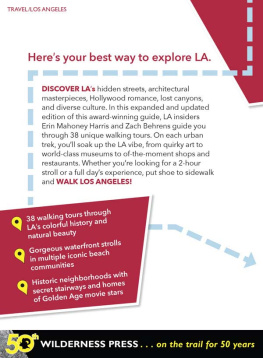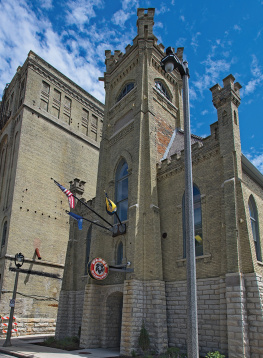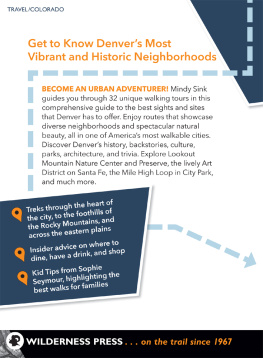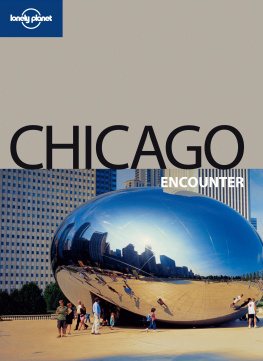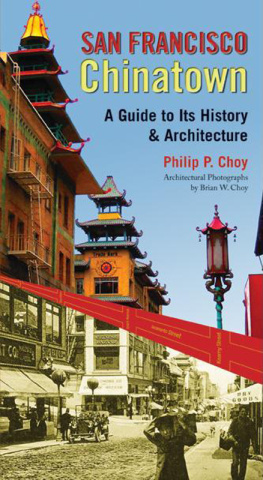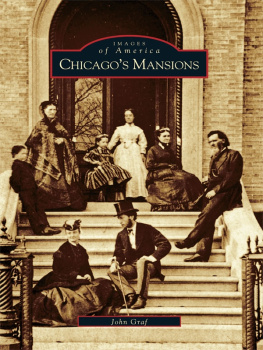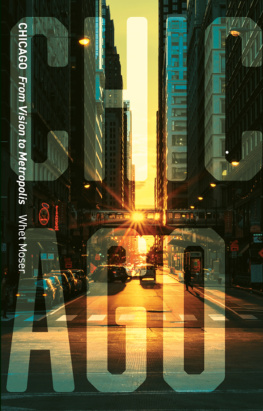
Walking Chicago: 31 tours of the Windy Citys classic bars, scandalous sites, historic architecture, dynamic neighborhoods, and famous lakeshore
1st EDITION September 2008
Copyright 2008 by Ryan Ver Berkmoes
Cover photos copyright 2008 by Ryan Ver Berkmoes
Interior photos: Ryan Ver Berkmoes, except p. 63, courtesy Mary Ann Bryan, www.beverlymorganpark.net
Maps: Bart Wright/Fineline Maps
Book and cover design: Larry B. Van Dyke
Book editor: Marc Lecard
Copyeditor: Jan Caroll
Layout: Beverly Butterfield, Girl of the West Productions
ISBN 978-0-89997-416-3
Manufactured in Canada
| Published by: | Wilderness Press |
| c/o Keen Communications |
| PO Box 43673 |
| Birmingham, AL 35243 |
| (800) 443-7227; FAX (205) 326-1012 |
| info@wildernesspress.com |
| www.wildernesspress.com |
Visit our website for a complete listing of our books and for ordering information. Distributed by Publishers Group West
Cover photos: Front, clockwise from upper right: Cloud Gate (a.k.a. The Bean), Millennium Park; Erie St. Park; gracious Victorian home in Andersonville; the Green Mill, Uptown; looking northeast from Sears Tower; Frank Lloyd Wrightdesigned home, Oak Park. Back, clockwise from upper right : Agora, by Magdalena Abakanowicz; farmers market in front of the Museum of Contemporary Art; Robie House.
Frontispiece: The iconic 333 Wacker Building, on the Riverwalk
All rights reserved. No part of this book may be reproduced in any form, or by any means electronic, mechanical, recording, or otherwise, without written permission from the publisher, except for brief quotations used in reviews.
SAFETY NOTICE: Although Wilderness Press and the author have made every attempt to ensure that the information in this book is accurate at press time, they are not responsible for any loss, damage, injury, or inconvenience that may occur to anyone while using this book. You are responsible for your own safety and health while following the walking trips described here. Always check local conditions, know your own limitations, and consult a map.
ACKNOWLEDGMENTS
Where to start? I am lucky enough to have a group of friends who Ive not only gone for a lot of walks with in Chicago, but who were enthusiastic about this book from the start. In no order: John Holden is a walking encyclopedia on the city; Howard Larkin is as good a walking companion as you could hope for; Susan and Chris Amati are wonderful walking companions (note subtle diplomatic difference). Yucking it up from Obamas to Veecks, Sandy Eitel has barely tapped research skills and could replace me at this, but dont tell her. Kelly McGrath was there the first night and the last; Ed Mazur brings new insight to Victor Mature and vast swaths of the city; Ed Lawler does the same for Beverly; Margaret Fosmoe kept me on track (now and in the past); James Borkman is my new official biographer; and Erin Corrigan made the dreams of the Gold Coast a dream. Others vital to happy walking and authoring: Pat Byrnes, Kate Campion, Janice Chambers, Bill & Alicia Derrah, Lisa Donovan, Dave Fell, Darel Jevens, Rick Kogan, Leo Burns and Mary Ann ORourke, Kathleen Pratt, Mark Rust and his iPod-deserving family, Nancy Ryan, author Lawrence P. Santoro, Mark Stewart, Becky Voelker, the incomparable Karla Zimmerman, Christine Zrinsky (who helped with some of the photos) and Roslyn Bullas, who sent the email that launched this project in the first place.
AUTHORS NOTE
Chicago is a wonderful city for walking for two reasons: a) its flat as a board, and b) its hard to get lost. You truly have to pound the pavement to work up a sweat most of year (excepting certain summer months when doing nothing can leave you drenched). And the street layout, with addresses that always include a north, south, east, or west, functions as an inherent GPS. Plus you can always remember the mantra: The lake is east. The lake is east.
The walks in this book have been chosen to allow you to explore the city in ways that even grizzled natives will find at times surprising. Concerns about personal safety and the character of neighborhoods are common for locals, whether justified or not. And some neighborhoods in this book have not always enjoyed the most sterling of reputations. But generally, during the day and with a few street smarts (if a corner looks dodgy, avoid it; skip the lonely alleys, etc.), you should be fine and be able to enjoy parts of Chicago often untrod. Bring friends, as theres always reassurance in numbers, and youll have more fun sharing the experience.
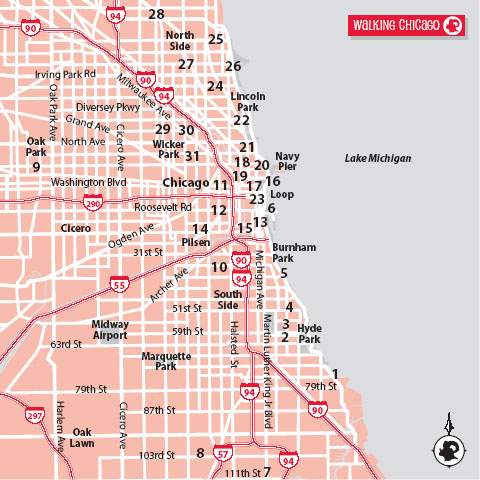
Numbers on this locator map correspond to Walk numbers.
INTRODUCTION
Can there be a better city for walking than Chicago? Neighborhoods reeking with character (some literally), a history that would be great fiction if it werent true, stirring architecture, 21 miles of lakefront, and parks worthy of an empire. If its not flat enough for you, there are several hundred good joints to plop down in and re-energizeand maybe have a touch of refreshment.
Walking in Chicago, you realize what a dynamic place it is. Every block yields a new surprise, discovery, or quirk. Every step leads to a unique view, whether its the soaring skyline seen from the lakefront or some tiny bit of urban drama glimpsed from the sidewalk. Follow the Chicago River and you encounter one new building after anotherfor better or worse. Prowl the streets of classic neighborhoods like Bridgeport, Little Italy and Wicker Park to see their very fabric changing right before your eyes.
Walking brings you close to the dreams of Chicagoans here and gone. Grand, cathedral-sized churches built for the ages by congregations that no longer exist are next door to small shops where families are just beginning their climb up the ladder. The citys experience hasnt been focus-grouped or market-tested. Rather, its there for you to take as you will, letting your own moods, interests and reactions shape your experience.
This books 31 walks span the city from the far south to the very north, from Oak Park in the west to the lakefront in the east. Difficulty of terrain doesnt play a factor in a city where the highest hills are usually curbs; you can follow right along as Chicago reinvents itself block by block with nothing to hinder your wanderings. New, old, rich, poor, beautiful, ugly, famous and infamousits all here. Choose a walk at random or with deliberation; maybe Ill bump into you around the next corner.

SOUTH SHORE: LAKEFRONT GENTILITY
BOUNDARIES: Jackson Park, Lake Michigan, E. 79th St., S. South Shore Dr.
DISTANCE: 4.7 miles (one way)
PUBLIC TRANSIT: Metra Electric to Cheltenham stop; 6 Jackson Park Express bus
Never as toney as other lakeside neighborhoods, South Shore has long been a middle-class refuge featuring excellent lakeshore views (the land bulging east means that you can easily look north to the bright lights of downtown). Many of the buildings date from the 1920s and 1930s when this neighborhood was home to a mix of white Protestants, Catholics and Jews. Like so many other parts of the city, South Shore had a deeply troubled racial transformation in the 1950s and 1960s, including riots at its beaches. Ironically, little has changed since the 1940s except the color of the residents skin. South Shore makes for a good lakeside walk. Revitalized park facilities take advantage of the stunning locations, and the communitys genteel roots are fully on display. In addition you can find surprises like one of Chicagos many Blues Brothers locations and several now tranquil beaches for getting your feet wet. The walk touches on Jackson Park.










